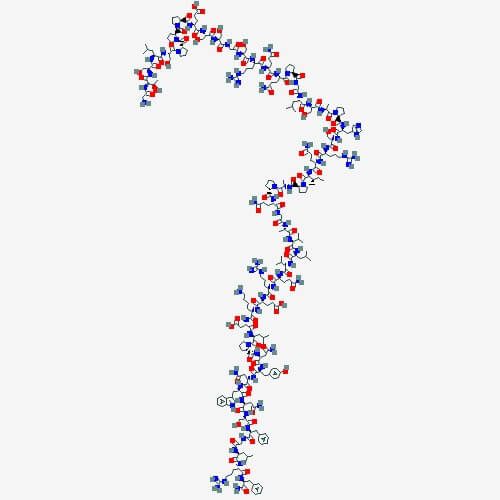KISSPEPTIN
Figure 1 2D structure image of kisspeptin PubChem identifier: CID 71306396

Kisspeptins and Precursor Protein
The KISS1 gene encodes prepro-kisspeptin, the 145 amino acid kisspeptin precursor. The cleavage products from prepro-kisspeptin are known as kisspeptins and these peptides of various lengths all include an Arg-Phe-NH2 motif at the carboxy-terminus. The decapeptide, kisspeptin-10, possesses the minimal peptide length to bind and activate KISS1R. The most abundant cleavage product is the 54 amino acid isoform known as kisspeptin-54 (KP54) or commonly referred to as kisspeptin. Less common isoforms include kisspeptin-14 (KP14), kisspeptin-13 (KP13) and kisspeptin-10 (KP10). In addition, the mammalian sequence of kisspeptin-54 is named kisspeptin1 where as another form occurs in non-mammalian organisms that is called kisspeptin2 (2).
Figure 2. Kisspeptins are formed by proteolytic cleavage of prepro-kisspeptin. Adapted from M.Tena-Sempere. GPR54 and kisspeptin in reproduction. Human Reproduction Update. 12(5), 631-639 (2006)

Regulation of the HPG Axis and Puberty
The KISS1 system plays a vital role in the regulation of reproduction and puberty. The system signals increased gonadotrophin secretion during puberty and establishes mammalian reproductive function and regulation of the hypothalamic-pituitary-gonadal (HPG) axis. By stimulating release of endogenous GnRH, kisspeptin stimulates the secretion of the gonadotropins, luteinizing hormone (LH) and follicle-stimulating hormone (FSH), from the pituitary gland. In turn, this results in the release of sex steroids from the gonads. KISS1 expression increases abruptly at the time of puberty, which suggests that kisspeptin signaling is involved in triggering the onset of puberty. In addition, kisspeptin may contribute to generating preovulatory gonadotropin surge in females (4). Given that kisspeptin plays a key role in regulating reproduction, the kisspeptin signaling pathway is a therapeutic target in reproductive disorders.
Role in Metabolism
More recently, kisspeptin was shown to play a part in glucose homeostasis, locomotor activity and body weight control (4). A tri-hormonal regulatory circuit exists between pancreatic α-cells, hepatocytes and β-cells. Glucagon, produced by α-cells in the Islets of Langerhans, stimulates cAMP-PKA signaling. In turn, this signaling up-regulates transcription of the gluconeogenic gene program and of KISS1. This leads to increased production of glucose and hepatic glucose output, and to the production of kisspeptin1. Glucose stimulates insulin secretion, whereas kisspeptin1 inhibits insulin secretion from pancreatic β-cells (5). Regarding locomotor activity, research with Kiss1R KO (knock-out) mice has shown that in the absence of KISS1R signaling, locomotor activity is dramatically reduced and accompanied by reduction in food intake and energy expenditure. In addition, studies have shown that in the absence of KISS1R signaling, there is increased body weight and impairment of glucose homeostasis in female but not male mice (3).
Kisspeptin and Sexual Attraction
Kisspeptin was also found to enhance activity in parts of the human brain associated with love and sexual arousal. Olfactory and visual signals are central inputs involved in sexual attraction. A recent study demonstrated that kisspeptin enhances brain activity in response to olfactory and visual cues of attraction in healthy men. Due its link to attraction, researchers are investigating if kisspeptin therapeutics may have potential to treat psychosexual disorders in addition to common reproductive disorders (6).
Conclusion
The roles for kisspeptin are multi-faceted with involvement in cancer, reproduction, metabolism and attraction. Consequently, there is interest in developing kisspeptin agonists and antagonists as therapeutics for a range of conditions. To support life scientists and researchers studying kisspeptin, Bachem offers a selection of kisspeptin peptides in addition to a comprehensive custom synthesis services.
References
1) W.Dhillo. Timeline: Kisspeptins. Lancet Diabetes Endocrinol. 1(1), 12-13 (2013)
2) C.M.Tevisan et al. Kisspeptin/GPR54 system: What do we know about its role in human reproduction? Cell Physio. Biochem. 49, 1259-1276 (2018)
3) K.P.Tolson et al. Impaired kisspeptin signaling decreases metabolism and promotes glucose intolerance and obesity. J. Clin. Invest. 124(7), 3075-3079 (2014)
4) M.A.Hussain et al. There is kisspeptin – and then there is kisspeptin. Trends Endocrinol. Metab. 26(10), 564-572 (2015)
5) W.Song et al. Glucagon regulates hepatic kisspeptin to impair insulin secretion. Cell. Metab. 19(4), 667-681 (2014)
6) L.Yang et al. Kisspeptin enhances brain responses to olfactory and visual cues of attraction in men. JCI Insight. 5(3), e133633 (2020)
KISSPEPTINS IN CLINICAL DEVELOPMENT
The neuropeptide kisspeptin-54, initially named metastin, was first discovered in 1996 as a metastasis suppressor. Subsequently, kisspeptin-54 was found to stimulate gonadotropin-releasing hormone (GnRH) release. The kisspeptins are a family of peptides encoded by the KISS1 gene, which are formed from proteolysis of their common precursor called prepro-kisspeptin (1). Due to involvement in tumor suppression, puberty, reproduction, metabolism and other roles in humans, kisspeptins are of interest for therapeutic applications. Currently, there are two kisspeptins and a kisspeptin analog in Phase II of clinical development as shown in Table 1.
| Product Name | Company or Organization | Highest Phase | Indication |
|---|---|---|---|
| Kisspeptin-10 | Massachusetts General Hospital | Phase II | Hyperprolactinemia, Secondary (Hypogonadotropic) Hypogonadism |
| Kisspeptin-54 | Imperial College London | Phase II | Female Infertility |
| MVT-602 | Myovant Sciences Ltd | Phase II | Female Infertility |
Candidates
At Massachusetts General Hospital, kisspeptin-10, a kisspeptin-1 receptor (KISS1R) agonist, is under investigation for the treatment of hyperprolactinemia or high prolactin levels, secondary (hypogonadotropic) hypogonadism and delayed puberty. In 2016, Massachusetts General Hospital registered a Phase II trial of kisspeptin-10 in patients with hyperprolactinemia (1).
Scientists at the Imperial College of London are developing kisspeptin-54, a KISS1R agonist, for in-vitro fertilization (IVF) treatment. Kisspeptin-54 stimulates reproductive hormone secretion and is responsible for the release of reproductive hormones that result in oocyte maturation and ovulation (1). The technique developed at Imperial College of London uses kisspeptin-54 to stimulate egg development instead of typical fertility drugs. In 2014, the Imperial College of London reported results from a Phase II study of kisspeptin-54 in IVF treatment. Study results showed single-injections of kisspeptin-54 induced egg maturation in patients during IVF therapy (3).
Myovant Sciences is developing MVT-602, a KISS1R agonist, for the treatment of female infertility. In October 2018, the company presented data from a Phase I trial of MVT-602. The study results showed that administration of MVT-602 in healthy premenopausal women in the follicular phase produced a dose-related increase in luteinizing hormone (LH) concentrations and post-dose increases in follicle-stimulating hormone (FSH) and estrogen (1). In 2019, Myovant Sciences presented results from a Phase IIa trial showing that the administration of MVT-602 produced an LH surge close to the natural mid-cycle LH surge and was associated with high rates of ovulation (2).
Conclusion
Kisspeptins hold potential as new therapies for reproductive disorders. In addition, they may be useful in the treatment of sex-steroid-dependent diseases and metastatic cancers. For organizations and researchers studying the kisspeptin/KISS1R system, Bachem offers kisspeptin research peptides. In addition, Bachem offers a comprehensive custom peptide synthesis service, and the production of New Chemical Entities .
References
1) H.Clarke et al. Comprehensive review on kisspeptin and its role in reproductive disorders. Endocrinol. Metab. (Seoul), 30(2), 124-141 (2015)
2) GlobalData (2020)
3) MVT-602, Myovant Sciences (2020)
4) C.N.Jayasena et al. Kisspeptin-54 triggers egg maturation in women. J. Clin. Invest., 124(8), 3667-3677 (2014)
MEET BACHEM: HERBERT ZIHLMANN
What is your official job title at Bachem?
My official job title is Specialist Marketing and Graphic Designer.
How long have you been with Bachem? Where did you work before Bachem?
I have been working at Bachem since November 15, 2019. For the longest time I worked as a graphic designer for an insurance company. In the last few years I worked as a freelance brand and graphic designer.
Briefly, what do you do at Bachem?
I develop a brand identity our consumers identify with. My work is based on graphic-, motion- and brand-design.
What is your academic background/degrees or training?
I obtained a Bachelor’s degree in arts at the FHWN in Basel in 2011. I have specialized in new media and since 2009 I have been working as a freelance designer alongside my student jobs.
What do you like to do outside of work?
Herbert: I love to create and make things. The creative process is very important for me. My other passion is hiking, I love it to find new places and explore the world.
How is the Marketing & Sales team partnering with their customers?
We are striving to present our products in the best possible way. Our Marketing Teams is constantly trying to give our customers a real experience of passion for our products.
Thank you very much Herbert.

Peptide highlights
Interesting news about peptides in basic research and pharmaceutical development:
An experimental peptide could block Covid-19-MIT News
Researchers gain new insights into pain signaling in the brain-EurekAlert!
New technique has potential to protect oranges from citrus greening-ScienceDaily
Brain cancer CAR T cell therapy guided by scorpion toxin starts first human trial-Genetic Engineering & Biotechnology News
LITERATURE CITATIONS
Bachem peptides and biochemicals are widely cited in research publications. Congratulations to all our customers with recent publications!
A.Abbara et al.
FSH requirements for follicle growth during controlled ovarian stimulation.
Frontiers in Endocrinology 10, (2019)
S.Ebrahimi Khonacha et al.
Kisspeptin-13 improves spatial memory consolidation and retrieval against amyloid-β pathology.
Iranian Journal of Pharmaceutical Research 18, 169-181 (2019)
C.Y.Lee et al.
Lipopolysaccharide reduces gonadotrophin-releasing hormone (GnRH) gene expression: role of RFamide-related peptide-3 and kisspeptin.
Reproduction, Fertility and Development 31, 1134-1143 (2019)
H.-M.Wu et al.
Kisspeptin regulation of human decidual stromal cells motility via FAK–Src intracellular tyrosine kinases.
